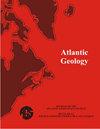Post-Devonian movement on the Fredericton Fault and tectonic activity in the New Brunswick Platform, central New Brunswick, Canada
IF 0.9
4区 地球科学
Q2 GEOLOGY
引用次数: 2
Abstract
The Norumbega Fault system is traced from southern New England to Prince Edward Island, and its major strike-slip history is pre-Carboniferous. Carboniferous and later movements are less well constrained. Along the Fredericton Fault in western New Brunswick, offsets affect outcrops of Carboniferous strata in several ways. Revision of Carboniferous stratigraphy in this area using new miospore data and mapping of new exposures augmented by LiDAR imagery permits refinement of some of the post-Devonian movement history. The oldest post-Silurian unit recognized, the Longs Creek Formation, is fault-dissected and tightly folded, with faults and folds overlapped by the unconformity at the base of the upper Visean Shin Formation. The age of the Longs Creek Formation is uncertain and may be late Devonian to early Visean. Faults affecting the Shin Formation and Royal Road basalts are truncated by the unconformity at the base of the Bolsovian Minto Formation. Beneath this unconformity the presence of fault-bounded panels of vertical Langsettian strata (Boss Point and Deerwood formations) along the Fredericton Fault demonstrate late Visean to Serpukhovian, and post-Langsettian, pre-Bolsovian (Duckmantian) movements. At least three phases of movement can be seen affecting the Minto Formation. All the movement phases along the Fredericton Fault appear to be right-lateral strike-slip, except for one phase of post-Bolsovian left-lateral displacement.加拿大新不伦瑞克省中部弗雷德里克顿断层后泥盆世运动与新不伦瑞克省地台构造活动
诺伦贝加断裂系自新英格兰南部至爱德华王子岛,其主要走滑史为前石炭纪。石炭纪及以后的运动就没有那么受约束了。沿着新不伦瑞克省西部的弗雷德里克顿断层,偏移以几种方式影响石炭纪地层的露头。利用新的微孢子数据和激光雷达图像增强的新暴露图对该地区石炭纪地层进行了修订,可以改进一些泥盆纪后的运动历史。已知的最古老的后志留统单元是朗斯溪组,它是断层解剖和紧密褶皱的,断层和褶皱在上维西安申组底部被不整合面重叠。朗斯溪组的时代不确定,可能是泥盆世晚期至维桑世早期。影响Shin组和Royal Road玄武岩的断层被Bolsovian Minto组底部的不整合所截断。在这一不整合之下,沿弗雷德里克顿断层的垂直Langsettian地层(Boss Point组和Deerwood组)的断层边界面板显示了晚Visean到Serpukhovian以及后Langsettian和前bolsovian (Duckmantian)运动。至少有三个阶段的移动可以看到影响Minto阵型。弗雷德里克顿断裂带的所有运动阶段都表现为右旋走滑,除了一个阶段为后博尔索期左移。
本文章由计算机程序翻译,如有差异,请以英文原文为准。
求助全文
约1分钟内获得全文
求助全文
来源期刊

Atlantic Geology
GEOLOGY-
CiteScore
2.10
自引率
18.80%
发文量
0
审稿时长
>12 weeks
期刊介绍:
Atlantic Geology (originally Maritime Sediments, subsequently Maritime Sediments and Atlantic Geology) covers all aspects of the geology of the North Atlantic region. It publishes papers, notes, and discussions on original research and review papers, where appropriate to the regional geology.
 求助内容:
求助内容: 应助结果提醒方式:
应助结果提醒方式:


